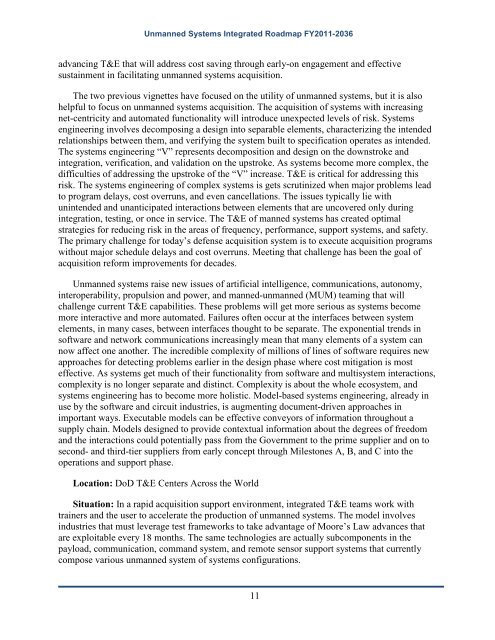Unmanned Systems Integrated Roadmap FY2011-2036 - Defense ...
Unmanned Systems Integrated Roadmap FY2011-2036 - Defense ...
Unmanned Systems Integrated Roadmap FY2011-2036 - Defense ...
You also want an ePaper? Increase the reach of your titles
YUMPU automatically turns print PDFs into web optimized ePapers that Google loves.
<strong>Unmanned</strong> <strong>Systems</strong> <strong>Integrated</strong> <strong>Roadmap</strong> <strong>FY2011</strong>-<strong>2036</strong><br />
advancing T&E that will address cost saving through early-on engagement and effective<br />
sustainment in facilitating unmanned systems acquisition.<br />
The two previous vignettes have focused on the utility of unmanned systems, but it is also<br />
helpful to focus on unmanned systems acquisition. The acquisition of systems with increasing<br />
net-centricity and automated functionality will introduce unexpected levels of risk. <strong>Systems</strong><br />
engineering involves decomposing a design into separable elements, characterizing the intended<br />
relationships between them, and verifying the system built to specification operates as intended.<br />
The systems engineering “V” represents decomposition and design on the downstroke and<br />
integration, verification, and validation on the upstroke. As systems become more complex, the<br />
difficulties of addressing the upstroke of the “V” increase. T&E is critical for addressing this<br />
risk. The systems engineering of complex systems is gets scrutinized when major problems lead<br />
to program delays, cost overruns, and even cancellations. The issues typically lie with<br />
unintended and unanticipated interactions between elements that are uncovered only during<br />
integration, testing, or once in service. The T&E of manned systems has created optimal<br />
strategies for reducing risk in the areas of frequency, performance, support systems, and safety.<br />
The primary challenge for today’s defense acquisition system is to execute acquisition programs<br />
without major schedule delays and cost overruns. Meeting that challenge has been the goal of<br />
acquisition reform improvements for decades.<br />
<strong>Unmanned</strong> systems raise new issues of artificial intelligence, communications, autonomy,<br />
interoperability, propulsion and power, and manned-unmanned (MUM) teaming that will<br />
challenge current T&E capabilities. These problems will get more serious as systems become<br />
more interactive and more automated. Failures often occur at the interfaces between system<br />
elements, in many cases, between interfaces thought to be separate. The exponential trends in<br />
software and network communications increasingly mean that many elements of a system can<br />
now affect one another. The incredible complexity of millions of lines of software requires new<br />
approaches for detecting problems earlier in the design phase where cost mitigation is most<br />
effective. As systems get much of their functionality from software and multisystem interactions,<br />
complexity is no longer separate and distinct. Complexity is about the whole ecosystem, and<br />
systems engineering has to become more holistic. Model-based systems engineering, already in<br />
use by the software and circuit industries, is augmenting document-driven approaches in<br />
important ways. Executable models can be effective conveyors of information throughout a<br />
supply chain. Models designed to provide contextual information about the degrees of freedom<br />
and the interactions could potentially pass from the Government to the prime supplier and on to<br />
second- and third-tier suppliers from early concept through Milestones A, B, and C into the<br />
operations and support phase.<br />
Location: DoD T&E Centers Across the World<br />
Situation: In a rapid acquisition support environment, integrated T&E teams work with<br />
trainers and the user to accelerate the production of unmanned systems. The model involves<br />
industries that must leverage test frameworks to take advantage of Moore’s Law advances that<br />
are exploitable every 18 months. The same technologies are actually subcomponents in the<br />
payload, communication, command system, and remote sensor support systems that currently<br />
compose various unmanned system of systems configurations.<br />
11

















